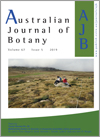Australian Journal of Botany
Volume 67
Number 5 2019
We review the literature from temperate grasslands in south-eastern Australia to develop a conceptual model that proposes the key multivariate drivers that underpin diversity. In this model, accumulated biomass governs the structure of grasslands and this, in turn, affects diversity through its effects on resource availability. We outline the key direct drivers of diversity in temperate grasslands – disturbance, resources and regeneration – in an effort to better understand how grasslands vary ecologically across their range, and why structure, function and diversity are more than outcomes of the amount of biomass singularly. Despite four decades of research, it is clear that our understanding of the multivariate drivers of diversity across the range of temperate grasslands in Australia is still incomplete. We identify key research questions that must be addressed to advance the conservation management of these endangered ecosystems.
The holoparasite Orobanche nowackiana is the only obligate serpentinophyte in Europe parasitising the Ni hyperaccumulator Alyssum murale. Pollen biology – morphology of pollen grains, pollen production and localisation of metals in pollen and anthers – is of importance for the reproductive success. Pollen morphological studies are important for taxonomy and support keeping the species in the genus Phelipanche.
Phosphorus is routinely applied to soils in tree-based restoration schemes despite the balance between beneficial and deleterious effects being poorly understood. For six woody species from the Great Western Woodlands of Western Australia, growth increased in response to low concentrations of applied phosphorus. At higher phosphorus concentration, growth either plateaued or declined. Applied phosphorus may have different and unpredictable effects on native species suggesting caution when applying high rates of phosphorus in a field-setting.
This paper provides detail on the first attempt to place an ecological value on groundwater dependent ecosystems on a statewide scale, in Australia. The work revealed that National ecological classification systems could be applied to groundwater at a scale that allows its use in policy decision-making. The results of the work have been used to guide water access rules in groundwater systems to protect high value terrestrial groundwater dependent ecosystems, within a risk management framework.
Acacia longifolia subsp. longifolia has become highly invasive in many parts of the world including Australia. To address this problem, seed germination of two populations of A. longifolia subsp. longifolia from Portugal and Australia have extensively studied in this study under different environmental factors. The findings of this study is directly beneficial for the management of long lived A. longifolia subsp. longifolia seed bank and hence to reduce its invasiveness.
Climate change has resulted in warmer, drier conditions in the Australian Alps, which increases the risk of previously rare widespread fires. Recovery of vegetation in the Australian Alps from fire is complicated but after 15 years, subalpine grasslands have recovered well, with only few compositional and structural differences remaining. This recovery over this disturbance-free period demonstrates the capacity to respond to fire but as fires are predicted to become more common with climate change, this capacity may be jeopardised.
Ecosystem management is complicated by the overlapping legacies of past land uses, and the different constraints and possibilities these impose. State-and-transition models can help managers by describing these legacies and categorising the available management opportunities in a readily interpretable format. Here, we develop a state-and-transition model for an endangered grassland ecosystem, and show how it can assist management planning, monitoring, reporting and communication.












